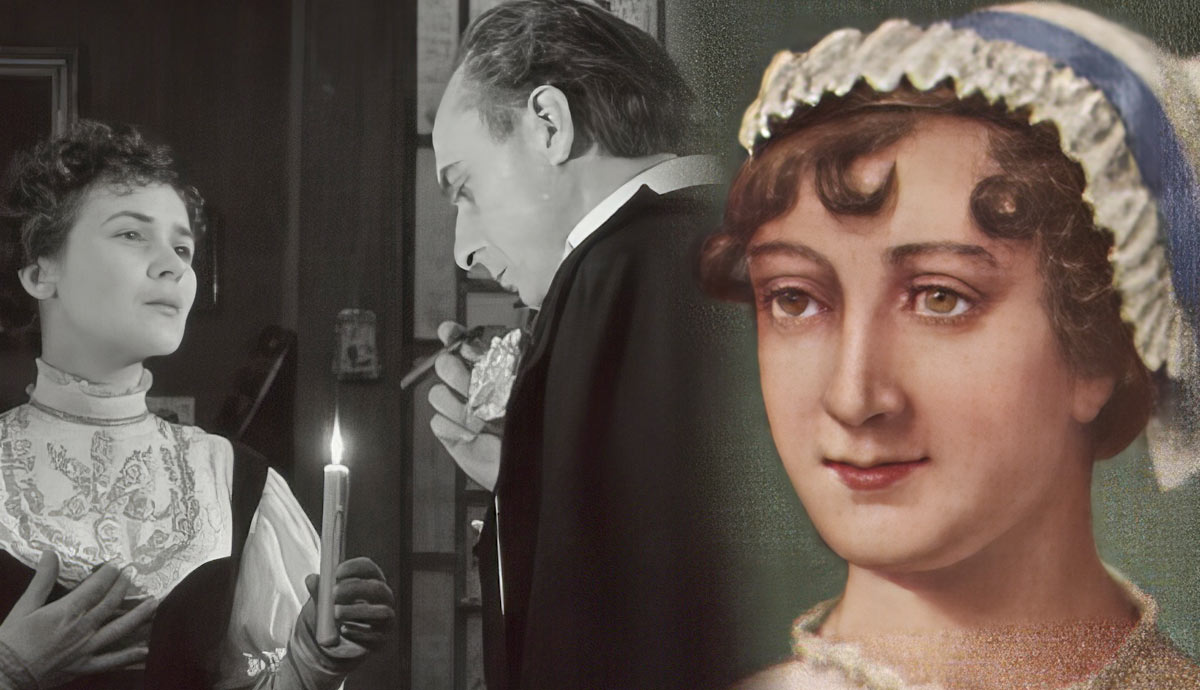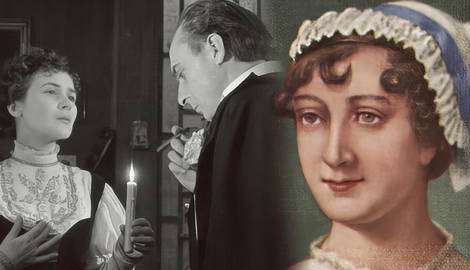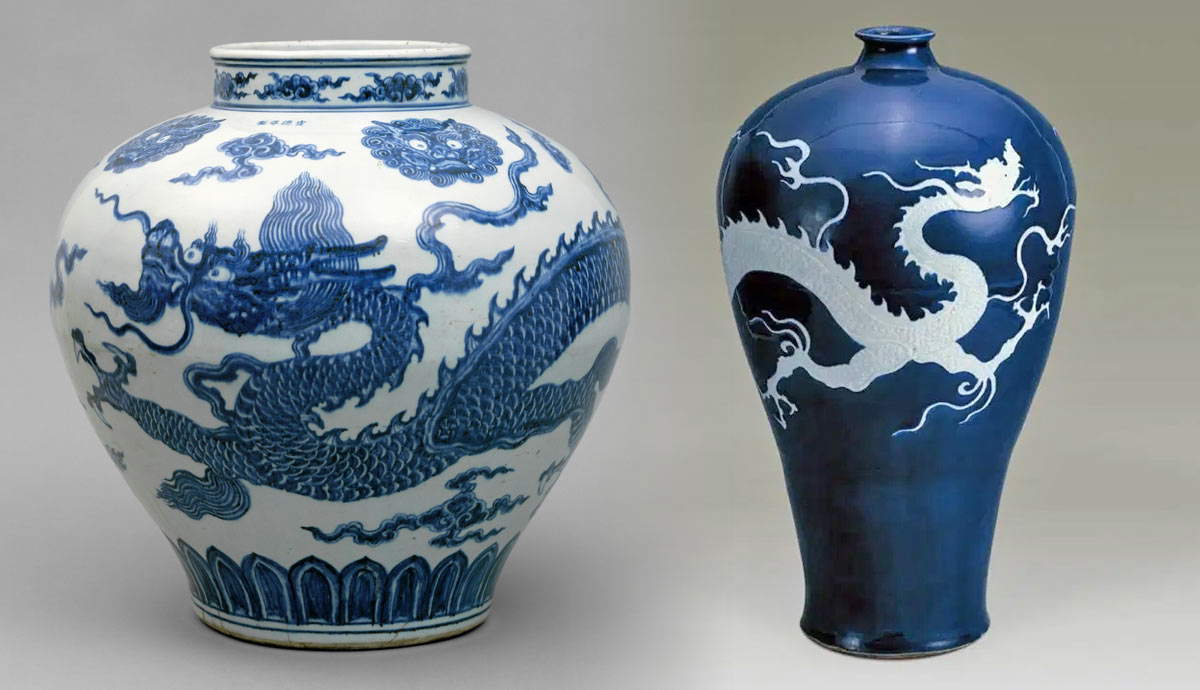
Jane Austen’s novels read as the ultimate in romantic fiction, where heroines fallen on hard times are saved by decent and powerful men. But reading against our sentimental instincts reveals a darker tale, with women excluded from property ownership and inheritance, leaving them forced to make choices the modern reader would consider repulsive. Coming only 66 years after Austen’s work, Ibsen’s representation of women as equally confined by social expectations and legal bonds, yet they possess an untapped agency to escape them. Ibsen’s new portrayal signifies a significant departure in the representation of women in literature and signals an important cultural shift in the Western canon.
Jane Austen’s Pride and Prejudice as a Tale of Despair?

Jane Austen’s most famous novel, Pride and Prejudice, is memorable for its misunderstandings, its cunning rakes, and its often socially awkward savior, Mr. Darcy. Driving the plot, however, are the complex rules of inheritance by which the Bennet family’s property is bound, leaving it destined to be passed to the next male relative upon Mr. Bennet’s death. With the Bennet family producing only daughters, this means that the family home will go instead to the previously unknown cousin, Mr. Collins, casting the Bennet women as potentially and imminently homeless.
Meeting Mr. Collins as he gleefully arrives to survey his eventual inheritance, both readers and the Bennet family are struck by his repulsive nature, his poor manners, and his suffocating sense of entitlement, with these qualities functioning as no accident or coincidence, serving as they do to enhance our revulsion at not just character but situation. Austen’s loathsome construction of Collins consolidates not just our sense of the female characters’ vulnerability but also their own awareness of the cruel and degrading circumstances they find themselves in as women at the start of the 19th century.
While the plot spirals from here, introducing the reader to a cast of men who intrude on the lives of the Bennet sisters, their limited options due to their exclusion from inheritance and finance are fundamental to the choices and compromises these women will make. Even the most sunlit and romantic moment of the text is a compromise made in the shadow of destitution.
A Doll’s House and Illegal Debt

In A Doll’s House, playwright Henrik Ibsen sets up a similar conflict, in which the respectable wife Nora is unable to borrow money due to her subordinate legal status as a married woman. This limitation stimulates Nora, when faced with the problem of her husband’s ill health, to forge his signature in order to acquire a loan with which she will pay for his convalescence overseas.
Here, and in Pride and Prejudice, the authors set up the plot’s problem as reliant on the main character’s gender and legal status in relation to assets. Neither plot would function logically without this significant inhibition of personal agency, and both texts can be read as explorations of this as a social problem.
Inequality in Finance as a Social Problem

While one might think of the work of authors such as Mary Gaskell and Charles Dickens as being emblematic of the social problem novel, Austen and Ibsen both play with social issues in order to drive their characters forward, composing their work with the same purpose of highlighting inequality to their readers. In this way, we understand that both Austen and Ibsen, through their attempts to engage their readership in the topic, are optimistic about their powers to influence the status quo; however, staying within the realm of the text allows us to understand Austen as significantly more pessimistic about the situation women without financial agency find themselves in.
Lost Property in Sense and Sensibility

When surveying Austen’s body of work, readers may notice that the issue of inheritance and entailment regularly occurs as an event with which to set the characters in motion, much as it does in Pride and Prejudice. In Austen’s first novel, Sense and Sensibility, the threat that looms over the Bennet family in Pride and Prejudice is realized and played out when the Dashwood sisters and their mother are forced to leave the family home upon Mr. Dashwood’s death. The property, entailed to the son, John Dashwood, is taken over by him and his new wife, leaving the original occupants homeless.
What is crucial in this scenario is the late Mr. Dashwood’s faith in his son to act honorably in providing the continued shelter of the women, with a promise secured on his deathbed and no alternative provision made for the women. However, John’s selfishness puts paid to that once the worst happens, and the female relatives are forced to rely on the kindness of others.
Female Vulnerability to Exploitation

Just as Anne Brontë does, both Ibsen and Austen look coldly at human nature, considering how female fiscal vulnerability invites the unscrupulous to exploit. In A Doll’s House, this opportunistic behavior is embodied by Krogstad, who, as the employee of Nora’s husband, is both about to lose his job at the bank and aware of Nora’s financial indiscretion.
With the knowledge of Nora’s forgery, Krogstad attempts to leverage her vulnerability in order to save himself, echoing the manner in which John Dashwood sacrifices his mother and sisters to secure his own financial stability. Here, we find both Sense and Sensibility and A Doll’s House illustrating how, without financial agency, women become pawns in the games of those who hold power.
Escaping this web that holds them in place requires women in Austen’s novels and in Ibsen’s play to contort themselves into a series of alarming and compromising shapes. In Austen’s work, these contortions are located most readily in the choices women must make around marriage.
Family Pressure and Personal Choice

Meeting the Elliot family In Persuasion, we again find a property entailed to a male heir, this time the hitherto unknown cousin William Elliot. Unlike the abdication of responsibility demonstrated by brother John Dashwood in Sense and Sensibility, Elliot’s qualities as an outsider align him far more closely with callous Mr. Collins in Pride and Prejudice; however, his manipulative strategies duplicate those found in A Doll’s House, where Krogstad conceals reality to serve his own goals.
Arriving relatively late in the plot, William Elliot holds multiple women in his duplicitous sights, but his operations stimulate the reader’s sympathy most readily in his attempts to charm the novel’s heroine, Anne. With William’s potential marriage to Anne ensuring that he could secure the property currently entailed to him, this plan is necessary due to the currently widowed Mr. Elliot’s potential marriage to the charmless Mrs. Clay, which would leave open the possibility for a new male heir to supplant William, thus denying his eventual claim on the Elliot’s property, Kellynch Hall.
While Anne’s marriage to William would certainly benefit the man himself and explains his performance of romantic love, there is no escaping how the union would also be hugely beneficial to her wider family, including her unmarried elder sister and feckless father. This external pressure to secure the family home through marriage enhances the sense of Anne throughout the whole novel as pulled in various directions as both daughter and potential wife, exposing how infrequently the luxury of marrying for love was available even for wealthy families at the time.
The Humiliation of Female Infantilization

In this sense, false choices and compromises underpinned by the inability to inherit animate the work of Austen in much the same way that Ibsen’s Nora must herself offer a series of degrading performances in order to conceal the nature of her crime. This self-humiliation in the service of personal salvation is never more explicit than when Nora, desperate to misdirect her husband’s attentions, draws herself into a pantomime in which she is too inept to even learn a simple dance, thus demanding Torvald’s ongoing tutorship. In much the same way as readers wince to see the Dashwoods diminished in their small cottage and Anne misled by a classic cad, audiences of A Doll’s House are invited by Ibsen to recoil at Nora’s demented dancing.
This cringe factor is woven throughout the script of A Doll’s House and highlighted from the outset by the indulgent yet diminutive language Torvald uses when engaging with his adult wife. Seen also is the fiercely paternalistic management of Nora’s existence, which Torvald exerts through not only the minuscule amounts of cash he benevolently bestows on his wife but also his control of her consumption of indulgences such as sweets. With pocket money and treats limited and controlled, Nora’s status as a dependent is emphasized from the very outset of the play.
Ibsen’s lack of subtlety in setting up this dynamic of infantilization is necessary since, unlike Austen’s Bennet sisters in Pride and Prejudice, Dashwood daughters in Sense and Sensibility, or brave Anne in Persuasion, Nora’s problems will not be resolved through matrimony. By contrast, Ibsen has plans for Nora far more subversive than Austen dared to dream of less than a century before.
Marriage as Resolution

Notable in all of Austen’s works is the plot’s conclusion marked by marriage. In Pride and Prejudice, Elizabeth Bennet is eventually wed to the kind and wealthy Mr. Darcy, providing financial resolution in the form of a bigger and better property than that slated to be lost and at least kicking the question of inheritance down the road for one more generation. Similarly, in Persuasion, Anne marries her beloved Wentworth, acting both in accordance with her original desires and in alignment with financial security.
Less romantically, in Sense and Sensibility, Marianne finds resolution in her union to the stable yet much older Colonel Brandon, offering virtue in the face of vice and promising at least a life of security. This event, occurring as it does in Austen’s first novel, is notable since it most explicitly illustrates her theme of compromise with little of the romantic consolation of her later work.
Stripped of the romance injected by a dashing Mr. Darcy or heroic Wentworth, Sense and Sensibility underscores Austen’s pessimistic thesis most coolly. To be a woman in Austen’s era is to be compelled to settle in order to secure one’s own salvation.
Emancipation as Resolution

On the other hand, Ibsen has Nora exiting rather than entering a marriage, reaching for emancipation over protection in a manner modern readers will find far more familiar. Reading through the end of A Doll’s House, readers are struck by Nora’s language of female liberation, of finding herself, and of personal responsibility and self-knowledge. For Nora, the threat of destitution pales in contrast to the danger of erasing herself in the service of her husband, and far more is to be lost through self-compromise than by whittling away a small space for herself somewhere in the world.
In this way, Austen’s novels, however skillfully they illustrate the social problems of women born to wealthy and landed families, are pessimistically inhibited by their narrow scope. Ibsen’s writing looks optimistically to new horizons where personal integrity is valued more highly than material wealth, and the trappings of the home are things to be shed, should they hinder one from truly being. This novel optimism signals the dawn of a new era, a new conception of the individual, and a new value system taking shape, far closer to the one we work within in the present day.








